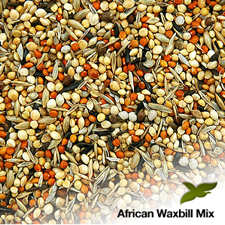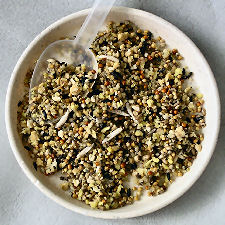Blue-capped Cordon Bleu Waxbill
Blue capped | Blue headed | Cordon Bleu Waxbill
Feeding for successful breeding
My first mix, recommended by Richard Prosser -
- 15kg – Foreign finch
- 3kg – Panicum
- 3kg – Japanese millet
- 3kg – Red millet
- 3kg – Plain canary
- 2kg – Niger
As the Blue-capped wasted a lot of this by sweeping through it seeking what they liked, I changed to Probird's African Waxbill Mix.
This was a Belgium mix of 11 seeds which worked much better. Unfortunately, the composition wasn't revealed, and Probird closed
Changing to this mix of smaller seeds virtually stopped seed scattering, reducing wastage and cost. So, try different mixes, especially using grass-like, seeds.

Grit is always available. Grated cuttlefish is no longer given as calcium and vitamins are now in the eggfood mix
Thawed frozen buffalo worms and Pinkies are given several days a week. Pinkies (fly maggots) are usually more 'popular' www.kiezebrink.co.uk
Too much livefood to pairs without chicks can induce 'battery-hen syndrome' (described below)
UK frozen livefood mail order supplier - www.priorspetproducts
For successful parent rearing, the balance of protein obtained from the rearing food and livefood must be just right
Only experience can help here
Too much protein/ livefood and the over-stimulated cock ejects the chicks, wanting to breed again
Too little and the chicks don't develop as fast as they should so are abandoned at about day 9
Very frustrating but the right balance is the key
Volume of eggfood supplied varies. It depends upon what birds are up to ie breeding or resting
Also, add diced chicory
I now use a rearing mix based on that used by the very successful Paul de Nil
Paul de Nil is one of Belgium's most successful Waxbill breeders. He attributes much of his success to his rearing food
Blue-capped Waxbills generally like his mix but some just pick out the Pinkies and eat little of the eggfood. Others can't get enough
Below is the lazy man's guide to making this eggfood

Paul makes his in the most cost-effective manner starting with white bread and eggs. Although a little more expensive, it is even easier to start with your normal, eggfood
The weights of eggfood given are basd on Gold-label Feast™
If you use a dry rather than a pre-moistened eggfood ie Cede™ it is a bit less dense. Perhaps decrease the weight of dry eggfood added by say 20%
To well drained seed, add eggfood with vitamins, Calcivet™, probiotic and charcoal. The addition, and use of pollen, is discussed on the next page which deals with 'conditioning'
Stir/ mix - thoroughly
Then add and stir in frozen livefood (ie Pinkies and buffalo worms)
Seal entire mix in several, fairly small, plastic bags and freeze
Take sufficient for 3 or 4 days at a time and thaw. Only experience will allow you to judge how much to thaw. Freeze mix in several plastic bags, each as a thin layer (1 - 1.5 cm/ half inch

Then just break a suitably sized piece off to thaw
Thawed mix can be kept in the fridge and used for up to a week as required (4 days maximum is probably safer)
If you have several different types of bird then mix the seed accordingly
If you have Bullfinches which consume twice the amount of their seed than your foreign finches, then, mix two parts of your Bullfinch mix to one part of your foreign finch mix
If you have kept the shells of two hens eggs eaten recently, you can bake or microwave them crumble and add to the seed
If grated cuttlefish or crumbled eggshell is always available then this isn't necessary
Use of rearing food is continued on the next page, discussed under 'conditioning'
www.lavender-waxbill.com
www.parrot-finches.com
www.waxbillfinchsociety.org.uk/
www.welcomewildlife.co.uk
www.snorkellingphotography.com







